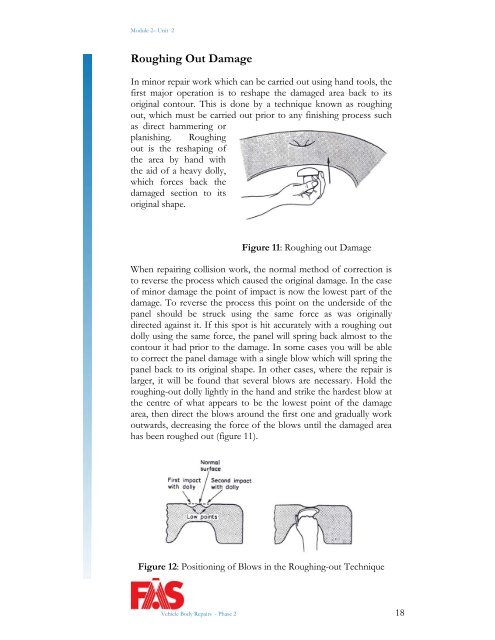TRADE OF VEHICLE BODY REPAIR - eCollege
TRADE OF VEHICLE BODY REPAIR - eCollege
TRADE OF VEHICLE BODY REPAIR - eCollege
Create successful ePaper yourself
Turn your PDF publications into a flip-book with our unique Google optimized e-Paper software.
Module 2– Unit 2<br />
Roughing Out Damage<br />
In minor repair work which can be carried out using hand tools, the<br />
first major operation is to reshape the damaged area back to its<br />
original contour. This is done by a technique known as roughing<br />
out, which must be carried out prior to any finishing process such<br />
as direct hammering or<br />
planishing. Roughing<br />
out is the reshaping of<br />
the area by hand with<br />
the aid of a heavy dolly,<br />
which forces back the<br />
damaged section to its<br />
original shape.<br />
Figure 11: Roughing out Damage<br />
When repairing collision work, the normal method of correction is<br />
to reverse the process which caused the original damage. In the case<br />
of minor damage the point of impact is now the lowest part of the<br />
damage. To reverse the process this point on the underside of the<br />
panel should be struck using the same force as was originally<br />
directed against it. If this spot is hit accurately with a roughing out<br />
dolly using the same force, the panel will spring back almost to the<br />
contour it had prior to the damage. In some cases you will be able<br />
to correct the panel damage with a single blow which will spring the<br />
panel back to its original shape. In other cases, where the repair is<br />
larger, it will be found that several blows are necessary. Hold the<br />
roughing-out dolly lightly in the hand and strike the hardest blow at<br />
the centre of what appears to be the lowest point of the damage<br />
area, then direct the blows around the first one and gradually work<br />
outwards, decreasing the force of the blows until the damaged area<br />
has been roughed out (figure 11).<br />
Figure 12: Positioning of Blows in the Roughing-out Technique<br />
Vehicle Body Repairs - Phase 2 18
















